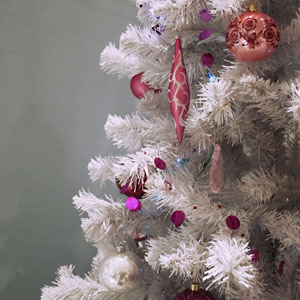 So I tend towards green-ness. I’m not an uber-environmentalist but I do what I can. I’m sitting here in my down jacket because I like to keep the thermostat relatively low in the winter, (and because it’s #@$% cold outside). We recycle. We don’t leave the water running when we brush our teeth. That kind of thing.
So I tend towards green-ness. I’m not an uber-environmentalist but I do what I can. I’m sitting here in my down jacket because I like to keep the thermostat relatively low in the winter, (and because it’s #@$% cold outside). We recycle. We don’t leave the water running when we brush our teeth. That kind of thing.
That means that when people say that real Christmas trees are evil and that fake trees are a more responsible choice (i.e., that plastic is greener than actual greenery), I am cowed enough to want to look into it before blithely buying another real tree this year. (Even though I LIKE real trees. A lot.)
My initial thoughts include:
– My community recycles (mulches) real Christmas trees. Does that count for anything?
– Christmas tree farms are better than strip malls, aren’t they? (But is that a false dichotomy? Maybe they tear down nice forests to plant the fertilized and insecticided Christmas trees.)
– Isn’t plastic, just, like, icky? And people don’t keep their plastic trees literally forever, do they? So is the environmental cost of dealing with giant hunks of plastic occasionally really less than dealing with gen-you-wine biodegradable trees annually?
So I set out to try to find out what is actually greener.
First, yes, it appears that plastic IS icky!
Some might make a case for fake trees, because they are re-used every year and thus don’t generate the waste of their real counterparts. But fake trees are made with polyvinyl chloride (or PVC, otherwise known as vinyl), one of the most environmentally offensive forms of non-renewable, petroleum-derived plastic.
And its ickiness is not limited to the obvious:
Furthermore, several known carcinogens, including dioxin, ethylene dichloride and vinyl chloride, are generated during the production of PVC, polluting neighborhoods located near factory sites. Most of those factory sites are actually in China, where 85 percent of the fake trees sold in North America originate. Labor standards there don’t adequately protect workers from the dangerous chemicals they are handling.
Eek. That’s not all, either. Evidently there is enough lead that the Children’s Health Environmental Coalition has issued a warning about the things shedding “lead-laced dust” on presents, etc. Eek again.
The same article addresses my question about whether mulching counts for anything — why yes it does! They say, “the sheer numbers of trees that get discarded after every holiday can be a big waste issue for municipalities that aren’t prepared to mulch them for compost.” (Emphasis added.) Mine is! Starting to feel better, here.
This Slate article is full of lovely, lovely numbers. Among other observations, it indicates that your real tree would need to travel 143 miles from the farm to your local lot to match the amount of fuel expended to get your fake tree to you. This is based on a fake tree getting 15 years of continuous use, which is evidently optimistic.
I often travel less than 20 miles to get my trees off of a real farm. When I don’t, my local nursery carries them and I’ll ask but I’m really pretty confident that it’s less than 143 miles away. Feeling better yet.
How about the strip mall vs. tree farm equation? (Isn’t that a fun one? Pretty much guaranteed to come out on top, there.) Here‘s some info, though:
In the United States alone, there are approximately 500,000 acres of Christmas Trees — that’s enough trees to provide 9 million people with fresh oxygen every day. Tree farms also reduce soil erosion, filter run off and provide food and shelter for wildlife, insects and plants. Not only are they aesthetically pleasing to look at, but they the trees are often grown on soil that would not otherwise be suitable for growing crops.
The pesticides remain a problem but overall, the conclusion seems to be that while each kind of tree has its issues, real trees are LESS evil than fake ones.
Disclaimers: First, I want to keep buying real Christmas trees and so am biased towards evidence that says “go ahead and buy real Christmas trees!” Second, I am not an arborist or anyone with any particular knowledge of this subject — just Googled “which is better for the environment live or fake christmas tree.” And read about a dozen of the results that looked most authoritative… but hey, they could all be wrong.
Several of the articles I read indicate that the MOST responsible choice is to get a live tree, complete with root ball, and just re-plant it when you’re done. This looks like a really cool option, for example (rented live trees complete with rootballs that are delivered, picked up, and replanted). Evidently there are some issues there, too — trees out of the ground are like “a fish out of water,” even with rootballs intact, and it’s kind of hard to avoid damaging them.
Meanwhile, I’ll go get my real Christmas tree this year with a lighter heart. Especially if it comes from a farm less than 143 miles away. (What if it’s 144 miles? Oh the angst.)
